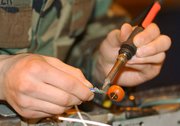Solder
|
|
A solder is a fusible metal alloy (often of tin and lead), with a melting point or melting range below 450°C (840°F) and is melted to join metallic surfaces, especially in the fields of electronics and plumbing, in a process called soldering.
In electronics, solders are usually 60% tin and 40% lead by weight in order to produce a near-eutectic mixture (lowest melting point - below 190°C). These are commonly designated Sn60/Pb40. The eutectic ratio of 63/37 corresponds closely to a Sn3Pb intermetallic compound. According to the European Union Waste Electrical and Electronic Equipment (WEEE) and Restriction of Hazardous Substances Directive (RoHS) directives, lead has to be eliminated from electronic systems by July 1 2006, leading to much interest in lead-free solders. These contain tin, copper, silver and other metals in varying amounts. The lead-free replacements for conventional Sn60/Pb40 solder have higher melting points, requiring re-engineering of all components and materials used in electronic assemblies, and produce mechanically weaker joints, which will lead to premature failure of products using such solders.
In plumbing, a higher proportion of lead was used. This had the advantage of making the alloy freeze more slowly, so that it could be wiped over the joint to ensure watertightness. With the replacement of lead water pipes by copper, the lead in plumbing solder was replaced by copper or antimony, with silver often added, and the proportion of tin was increased.
Hard solder, as used for brazing, is generally a copper/zinc or copper/silver alloy, and melts at higher temperatures.
In silversmithing or jewelry making, special hard solders are used that will pass assay. They contain a high proportion of the metal being soldered. Lead is not used in these alloys. These solders also come in a variety of hardnesses, known as 'enamelling', 'hard', 'medium' and 'easy'. Enamelling solder has a high melting point, close to that of the material itself, to prevent the joint desoldering during firing in the enamelling process. The remaining solder types are used in decreasing order of hardness during the process of making an item, to prevent a previously soldered seam or joint desoldering while soldering a new joint. Easy solder is also often used for repair work, for the same reason. Flux or rouge is also used to prevent joints desoldering.
Solder is commonly mixed with, or used with flux, a reducing agent designed to help remove impurities (specifically oxidised metals) from the points of contact to improve the electrical connection. For convenience, solder is often manufactured as a hollow tube and filled with flux. Most cold solder is soft enough to be rolled and packaged as a coil making for a convenient and compact solder/flux package. The two principal types of flux are acid flux, used for metal mending, and rosin flux, used in electronics, where the corrosiveness of the vapours that arise when acid flux is heated could damage components. Due to concerns over atmospheric pollution and hazardous waste disposal, the electronics industry has been gradually shifting from rosin flux to water soluble flux, which can be removed with deionised water and detergent, instead of hydrocarbon solvents.
Since solder can occasionally splash (due to the superheated flux inside or from contact with water in the cleaning sponge), it is recommended that one always wear safety goggles when soldering. Though small solder splashes on skin are painful, they usually do no lasting harm. For large-scale work, further protective clothing may be needed.
See also
External links
- Solder and flux selection guide (http://www.efdsolder.com/PDF/EFD_-_Alloy_%2B_Flux_Selection_Guide.pdf)de:Lötzinn

